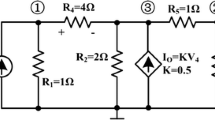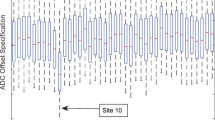Abstract
We discuss the design of a novel analog checker that monitors two duplicate signals and provides a digital error indication when their absolute difference is unacceptably large. The key feature of the proposed checker is that it establishes a test criterion that is dynamically adapted to the magnitude of its input signals, thus enhancing the accuracy of assessing their relative discrepancy. Consequently, when this checker is utilized in concurrent error detection, it diminishes the probability of both false negatives and false positives. Likewise, when employed for off-line test purposes, the checker supports both high yield and high fault coverage. In contrast, checkers implementing a static test criterion may only be tuned to achieve efficiently one of the aforementioned objectives.
Similar content being viewed by others
References
A. Chatterjee, “Concurrent Error Detection and Fault-Tolerance in Linear Analog Circuits Using Continuous Checksums,” IEEE Transactions on Very Large Scale Integration (VLSI) Systems, vol. 1, no. 2, pp. 138–150, 1993.
R. Gregorian and G.C. Temes, Analog MOS Integrated Circuits for Signal Processing, John Wiley and Sons, 1986.
J.L. Huertas, A. Rueda, and D. Vasquez, “Testable Switched-Capacitor Filters,” IEEE Journal of Solid-State Circuits, vol. 28, no. 7, pp. 719–724, 1993.
V. Kolarik, M. Lubaszewski, and B. Courtois, “Designing Self-Exercising Analogue Checkers,” in Proc. IEEE VLSI Test Symposium, 1994, pp. 252–257.
V. Kolarik, S. Mir, M. Lubazewski, and B. Courtois, “Analog Checkers with Absolute and Relative Tolerances,” IEEE Transctions on Computer-Aided Design of Integrated Circuits and Systems, vol. 14, no. 5, pp. 607–612, 1995.
M. Nicolaidis, “Finitely Self-Checking Circuits and Their Application on Current Sensors,” in Proc. IEEE VLSI Test Symposium, 1993, pp. 66–69.
J. Ramirez-Angulo, “High Frequency Low Voltage CMOS Diode,” Electronics Letters, vol. 28, no. 3, pp. 298–300, 1992.
H.G.D. Stratigopoulos and Y. Makris, “Concurrent Error Detection in Linear Analog Circuits Using State Estimation,” in Proc. IEEE International Test Conference, 2003, pp. 1164–1173.
Y. Tsividis, Operational and Modeling of the MOS Transistor, McGraw-Hill, 1999.
B. Vinnakota, Analog and Mixed-Signal Test, Prentice-Hall, 1998.
B. Vinnakota, R. Harjani, and W.-Y. Choi, “Pseudoduplication—an ACOB Technique for Single-Ended Circuits,” in Proc. IEEE International Conference on VLSI Design, 1997, pp. 398–402.
Author information
Authors and Affiliations
Rights and permissions
About this article
Cite this article
Stratigopoulos, HG.D., Makris, Y. An Analog Checker with Input-Relative Tolerance for Duplicate Signals. Journal of Electronic Testing 20, 479–488 (2004). https://doi.org/10.1023/B:JETT.0000042512.77744.d5
Issue Date:
DOI: https://doi.org/10.1023/B:JETT.0000042512.77744.d5




